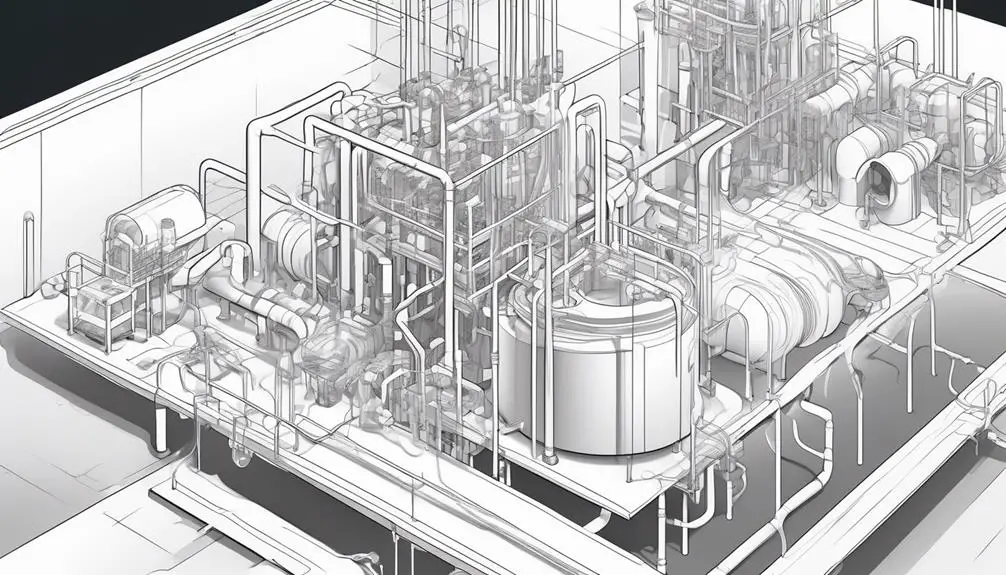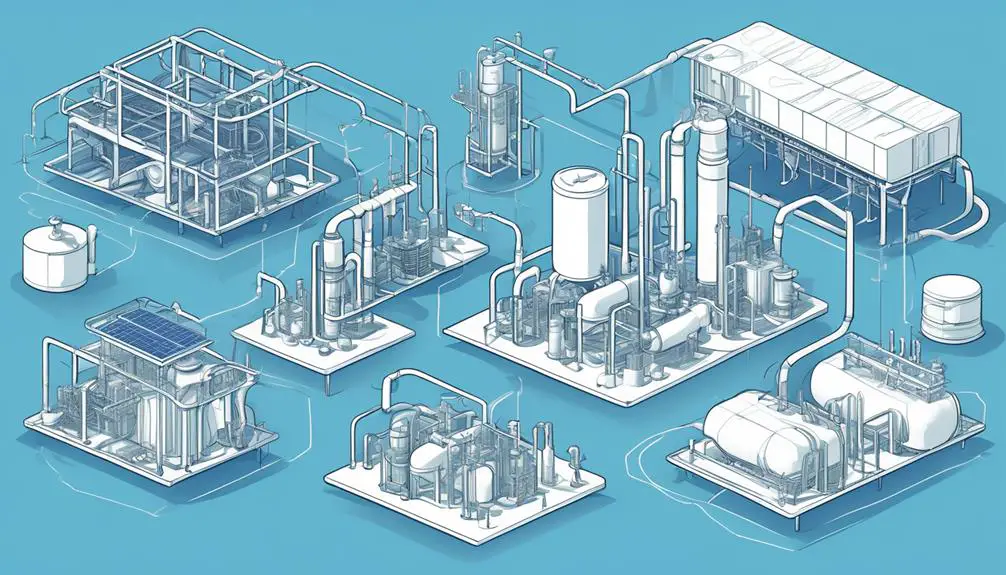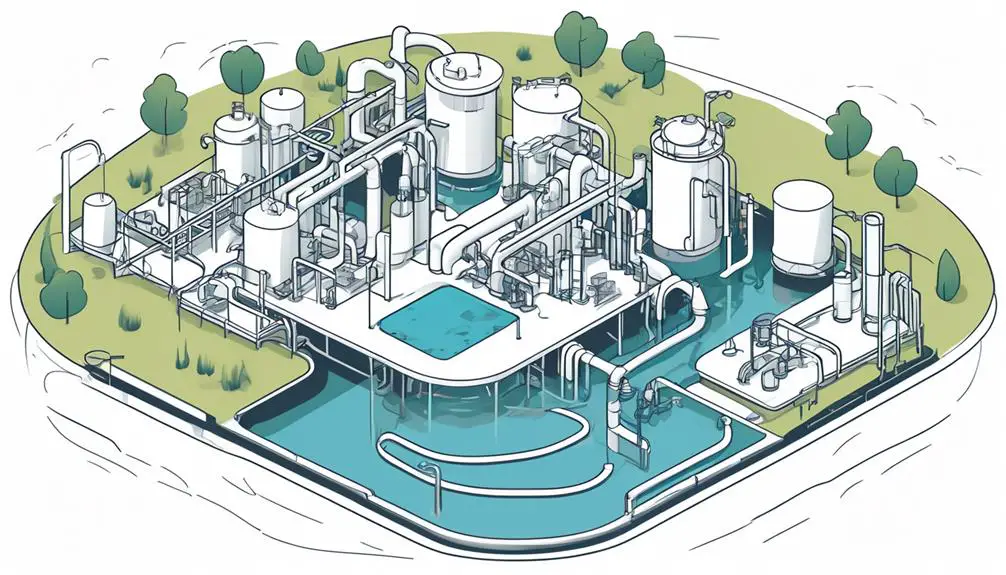Imagine a landscape where water flows cleaner, where technologies work tirelessly to cleanse and renew. Six innovations stand at the forefront, reshaping the way we treat wastewater.
From membranes that act as guardians, sifting impurities with precision, to solutions harnessing the power of the sun to create pure water from the sea, a new era of sustainability and efficiency emerges.
These advancements hold the key to a future where every drop counts, where waste transforms into a resource, beckoning a closer look into a world where innovation meets necessity.
Key Takeaways
- Advanced membranes and nanocomposite membranes are crucial for filtering impurities from wastewater and enhancing selectivity and resistance.
- Carbon-based purification technologies with high adsorption capacities play a significant role in effectively removing contaminants from water.
- Bio-based water remediation solutions offer an eco-friendly approach to transforming wastewater into biogas and fertilizers, making treatment processes sustainable and profitable.
- Innovations in water quality improvement, such as nanofiltration and UV technology for disinfection, are driving advancements towards cleaner water and a more sustainable future.
Membrane Technology Innovations
With a market value set to soar to $18.83 billion by 2023, membrane technology innovations are revolutionizing wastewater treatment processes.
These innovative technologies are like gatekeepers for water quality, using advanced membranes to filter out impurities and pollutants from wastewater.
Picture a microscopic sieve that only allows pure water molecules to pass through while trapping contaminants.
Nanocomposite membranes, a cutting-edge advancement, enhance selectivity and resistance in water treatment, making the process more efficient and effective.
Membrane technology plays a crucial role in ensuring that the water we use and consume is clean and safe for both human health and the environment.
By eradicating harmful substances from wastewater, these innovations are paving the way for a more sustainable and healthier future where access to clean water is no longer a luxury but a standard.
Embrace the wave of membrane technology innovations reshaping the landscape of wastewater treatment for the better.
Carbon-Based Purification Advancements
Let's talk about the exciting advancements in carbon-based water purification!
Picture this: Enhanced filtration systems that can trap impurities effectively, improved adsorption techniques that pull out pollutants like a magnet, and advanced activated carbon that cleans water like never before.
These innovations are revolutionizing the way we treat wastewater, paving the path for a cleaner, more sustainable future.
Enhanced Filtration Systems
Enhancing filtration systems through carbon-based purification advancements has revolutionized the efficiency of wastewater treatment processes. Carbon-based materials, with their high adsorption capacities, play a crucial role in optimizing water treatment processes. These advancements are instrumental in the effective removal of contaminants and pollutants from water sources, contributing to environmental preservation.
The market value of carbon-based purification advancements is projected to reach $7.73 billion by 2030, showcasing their importance in the industry. Research efforts are focused on enhancing the adsorption capabilities of these materials, further improving their efficiency. The expected growth trend for carbon-based purification advancements indicates a Compound Annual Growth Rate (CAGR) of 5.6%, highlighting their significance in advancing water treatment technologies.
- Carbon-Based Purification Advancements market value to reach $7.73 billion by 2030.
- Carbon-based materials exhibit high adsorption capacities in water treatment.
- Research efforts focus on optimizing adsorption capabilities of carbon-based purification advancements.
- Carbon-based purification advancements contribute to effective removal of contaminants and pollutants in water.
Improved Adsorption Techniques
Revolutionize your wastewater treatment processes with cutting-edge improvements in adsorption techniques using carbon-based purification advancements. Carbon-based materials boast high adsorption capacities, focusing on optimizing capabilities to remove organic contaminants effectively.
The current market value of these advancements sits at $4.98 billion, projected to reach $7.73 billion by 2030, with a growth trend showing a CAGR of 5.6%.
Advanced Activated Carbon
With advanced activated carbon, you can significantly boost your wastewater treatment processes by harnessing its high adsorption capacities for optimal contaminant removal. This innovation plays a pivotal role in enhancing resource recovery and reducing the carbon footprint associated with wastewater treatment.
Key points to consider include:
- Advanced activated carbon materials possess exceptional adsorption capacities.
- Research is actively working towards maximizing the adsorption capabilities of carbon-based purification advancements.
- These advancements are integral for effectively eliminating organic contaminants during wastewater treatment.
- Integration of advanced activated carbon in processes such as anaerobic digestion can lead to more sustainable and efficient treatment methods.
Bio-based Water Remediation Innovations
Bio-based water remediation innovations present an eco-friendly and sustainable approach to effectively remove contaminants while promoting biodegradation and ecosystem balance. These solutions not only clean wastewater but also offer a way to reduce our environmental footprint by turning waste into valuable resources.
By utilizing new technologies, bio-based water remediation processes can transform wastewater into biogas for energy production, agriculture fertilizers for sustainable farming practices, and heat for various applications. This innovative approach not only contributes to a cleaner environment but also helps in reducing our dependence on traditional resources.
Furthermore, these technologies play a significant role in the shift towards turning waste into revenue, making wastewater treatment processes more sustainable and profitable in the long run. Collaborative efforts and partnerships are essential in identifying and implementing these promising bio-based water remediation technologies to ensure a more eco-friendly and efficient wastewater treatment system.
Nanofiltration Breakthroughs

Nanofiltration breakthroughs bring cutting-edge technology to enhance membrane efficiency, filtering out impurities for cleaner water.
Imagine a filter so precise, it can sieve out even the tiniest contaminants, ensuring improved water quality.
With these advancements, nanofiltration is revolutionizing wastewater treatment processes, paving the way for a cleaner, more sustainable future.
Enhanced Membrane Technology
Experience the cutting-edge advancements in enhanced membrane technology, revolutionizing wastewater treatment processes with unparalleled efficiency and precision. Enhanced membrane technology is a pivotal player in the realm of wastewater treatment, offering innovative solutions to tackle contaminants and purify water effectively.
Key points to note about this new advancement include:
- Enhanced membrane technology is projected to grow at a CAGR of 10.8% by 2028.
- Nanofiltration, combining reverse osmosis and ultrafiltration, effectively sieves out divalent ions and organic molecules.
- Breakthroughs in nanocomposite membranes enhance selectivity and resistance in water treatment processes.
- The current market value of enhanced membrane technology stands at $1 billion, with expectations to reach $1.7 billion by 2028.
Improved Water Quality
Discover how breakthroughs in nanofiltration technology are transforming water quality for a cleaner and safer environment. Nanofiltration is at the forefront of sustainable water solutions, addressing pressing concerns like water scarcity and environmental impact.
By combining reverse osmosis and ultrafiltration, nanofiltration effectively sieves out divalent ions and organic molecules, significantly improving water quality. The market's rapid growth, projected to reach $1.7 billion by 2028, reflects the importance of these innovations.
Nanocomposite membranes play a crucial role in enhancing selectivity and resistance, leading to more efficient filtration processes. With a remarkable growth trend at a CAGR of 10.8%, nanofiltration is revolutionizing wastewater treatment, ensuring cleaner water for a healthier planet.
Water Disinfection Solutions Progress
Progress in water disinfection solutions is revolutionizing the way chemical contaminants are effectively tackled in wastewater treatment processes. The advancement in water disinfection techniques is crucial for the transformation of wastewater and ensuring the purification process is efficient and sustainable. Here are some key points to consider:
- Innovative UV Technology: Ultraviolet (UV) disinfection is gaining popularity for its ability to eliminate harmful microorganisms in wastewater, enhancing the overall treatment process.
- Oxidation and Degradation Mechanisms: Advanced techniques combine chemical oxidation with degradation mechanisms to target and break down chemical contaminants effectively.
- Biodegradation Promotion: Emphasizing biodegradation helps in the natural breakdown of pollutants, contributing to a more eco-friendly wastewater treatment approach.
- Long-Term Cost-Effective Solutions: The focus is on developing solutions that not only address immediate challenges but also provide sustainable, cost-effective methods for long-term water disinfection needs.
These innovations play a significant role in enhancing water quality, promoting eco-conscious practices, and ensuring the efficiency of wastewater treatment processes.
Desalination Developments

Building on the advancements in water disinfection solutions, the focus shifts to Desalination Developments in addressing freshwater scarcity in coastal regions. Desalination technologies play a crucial role in treating wastewater and turning seawater into a valuable resource.
Solar Desalination Technologies stand out for their sustainable approach, utilizing solar energy for efficient water purification. Nanofiltration Developments offer a cutting-edge solution by combining reverse osmosis and ultrafiltration to remove divalent ions and organic molecules, ensuring high-quality water output.
Constructed Wetlands for Wastewater Treatment provide a cost-effective method inspired by natural wetlands, promoting ecological balance during the treatment process. Additionally, Resource Recovery from Wastewater involves extracting valuable resources like nutrients, energy, and water from treatment plants, showcasing the integration of science and technology to maximize the efficiency of wastewater treatment processes.
These innovative desalination developments are revolutionizing the preservation and utilization of water resources in coastal areas.
Sustainable Urban Water Treatment Innovations
Sustainable urban water treatment innovations utilize advanced membrane technology, carbon-based purification methods, and bio-based remediation to enhance water quality and ecosystem health in densely populated areas.
- Membrane Technology: Growing at a CAGR of 8.7% to $18.83 billion by 2023, effectively removing contaminants and improving selectivity.
- Carbon-Based Purification: Projected to reach $7.73 billion by 2030, optimizing adsorption capacities and materials for cleaner water.
- Bio-Based Remediation: Offering cost-effective and eco-friendly solutions, promoting biodegradation and ecosystem balance in the treatment sector.
- Solar Desalination: Using sustainable energy sources to reduce the footprint of wastewater, addressing freshwater scarcity and fostering a shift towards sustainable urban water treatment innovations.
These innovations are crucial in the modernization of urban water treatment, ensuring a sustainable approach to water purification while minimizing the environmental impact on densely populated areas.
Resource Recovery Innovations

Moving from sustainable urban water treatment innovations, the focus now shifts towards resource recovery innovations in wastewater treatment processes. Cutting-edge membrane technology is eradicating contaminants, while nanocomposite membranes boost selectivity and durability.
Carbon-based materials with high adsorption capacities are being optimized for enhanced pollutant removal. Eco-friendly bio-based solutions are gaining traction for their cost-effectiveness and ability to promote biodegradation.
Solar desalination technologies are harnessing solar energy to purify water, aiding coastal regions facing freshwater scarcity and reducing reliance on traditional desalination methods. Nanofiltration advancements, combining reverse osmosis and ultrafiltration, are effectively removing divalent ions and organic molecules.
These innovations not only ensure clean water in treatment facilities but also have the potential to generate energy, especially through the utilization of solar energy. The transformative resource recovery innovations taking place are revolutionizing wastewater treatment processes, paving the way for sustainable and efficient solutions.
Wastewater Upcycling Innovations
To revolutionize wastewater treatment, consider the transformative potential of upcycling innovations in turning waste into valuable resources. When it comes to wastewater upcycling innovations, there are several key developments shaping the future of water treatment:
- Constructed Wetlands: Utilizing natural processes to treat wastewater, constructed wetlands offer an eco-friendly solution that enhances water quality and promotes biodiversity.
- Energy Efficiency: Innovations focusing on energy efficiency in wastewater treatment processes help reduce operational costs and lessen the environmental impact of treatment facilities.
- Resource Recovery: By extracting valuable resources such as nutrients, biofuels, and clean water from wastewater, resource recovery innovations contribute to a circular economy model.
- Smart Cities Integration: Implementing upcycling innovations in wastewater treatment aligns with the concept of smart cities, where sustainable practices play a crucial role in urban development and resource management.
These advancements not only improve the efficiency of wastewater treatment but also pave the way for a more sustainable and resourceful future.
Frequently Asked Questions
What Are the 6 Methodologies Used in Water Treatment?
In wastewater treatment, six key methodologies include membrane technology, carbon-based purification, bio-based solutions, solar desalination, nanofiltration, and more. These methods play crucial roles in purifying water, promoting sustainability, and addressing environmental concerns.
What Are the Advanced Technologies in Wastewater Treatment?
Discover cutting-edge wastewater treatment technologies like membrane advancements creating nanocomposite barriers that purify water like a sieve through sand. Explore carbon-based solutions and bio-remediation methods, revolutionizing sustainability in water treatment.
What Are the Emerging Technologies for Wastewater Treatment?
Discover emerging wastewater tech: Membrane advancements for contaminant eradication, carbon-based purifications increasing adsorption efficiency, bio-remediation for eco-friendly treatment, solar desalination tackling freshwater scarcity, and nanofiltration for ion and molecule separation. Exciting progress awaits!
What Is the New Technology for Water Treatment?
"Like a breath of fresh air, new water treatment tech is revolutionizing purification methods. It's efficient, eco-friendly, and cost-effective. Dive into these innovations to discover cleaner, safer water for all."
Conclusion
You've just witnessed the rise of wastewater treatment innovations, transforming dirty water into pure gold. Like a phoenix rising from the ashes, these advancements breathe new life into our environment, offering hope for a sustainable future.
Embrace these cutting-edge solutions as the key to unlocking a world where clean water flows freely for all. The journey towards a brighter, cleaner tomorrow starts now.
